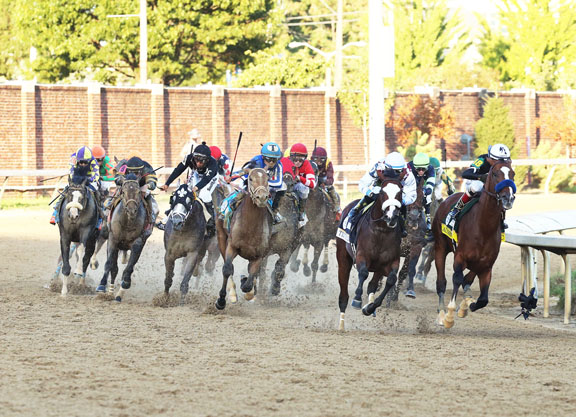By Marine Moussa
In Global Views, Godolphin Flying Start trainees provide insight into practices experienced and observations taken on their worldwide travels. First-year trainee Marine Moussa examines the impact of the Kentucky Derby points system that was implemented nine years ago.
The 147th running of the Kentucky Derby is this Saturday and the excitement after four months of preparation has reached its climax. The 20 contenders have qualified for the Kentucky Derby through a points system that was implemented in 2013. The system, called 'The Road to the Kentucky Derby', features 20 races for the preparatory season and 16 for the championship series. The 'Run for the Roses' used to be much more accessible to horses who had done their best running at two, and sprinters, when graded stakes earnings criteria was used to gain a position in the starting gate. Now, qualification for the race is weighted heavily towards 3-year-olds that have done their best running more recently and in races over a mile or longer.
Has the quality of the Kentucky Derby field changed since the Road to the Kentucky Derby was implemented? A look at the median Beyer speed-figure of each Kentucky Derby field taken from each runner's last start before the Derby did not suggest so. Comparing Kentucky Derby fields under the points system with what they would have been with the old graded stakes earnings system could be a lead for further research. What we can observe is not so much a change in the quality of the field, but a difference in composition of the Derby field to select and favour 3-year-old horses with Classic-distance form.
Before 2013, more horses that had picked up significant earnings in 2-year-old races, and sprinters, were eligible for the Derby. These horses may have had good 2-year-old form, but may not have trained on into their 3-year-old campaigns or excelled in two-turn races. Take the recent example of last year's GI Champagne S. and GI Hopeful S. winner Jackie's Warrior (Maclean's Music): He was a very good 2-year-old and considered an early favourite for the Derby, but he has been beaten in both his tries around two turns, indicating that he is a sprinter/miler rather than a Classic-distance colt, and that is the route connections have now taken. Under the old graded stakes earnings system, Jackie's Warrior would have qualified for a position in the Derby off his early 2-year-old form. The new system is weighted towards 3-year-olds that can make an impact at the American middle distances and that have more potential to be Triple Crown winners. Since the points system was implemented in 2013, there have been two Triple Crown winners–American Pharoah (2015) and Justify (2018)–within three years; The most recent Triple Crown winners previously had been Affirmed in 1978 and Seattle Slew in 1977. The points system rewards horses that can win or place in races just before the Derby. The goal is to have more true 1 1/4 mile horses running in top form closer to the Derby. Horses that exclusively did their best running at two get fewer points and 3-year-old sprint races get none.
It is also interesting to consider how the switch to the points system might affect how the race is run. There have been a few instances where sprinters–horses that did their best running at less than a mile before and after the Kentucky Derby–ran in the Derby and pressed the pace and tired before reaching the stretch, helping to set the race up for a stalker or closer. In the 133rd running of the Kentucky Derby in 2007, Teuflesberg–who won the one-mile GIII Southwest S. prior to the Derby and the seven-furlong GII Woody Stephen S. after–pressed the front-running Hard Spun before fading to finish 17th. Hard Spun stayed on for second, and the winner was the post-time favourite Street Sense, who was 19th of the 20 runners early. Interestingly, Teuflesberg's son, Trinniberg, had a similar run in the Derby in 2012. He sat second and pressed Bodemeister through some of the fastest fractions in the history of the race. Like Hard Spun, Bodemeister held second and Trinniberg faded to 17th; just like his sire, he was backing up by the time he reached the mile marker. The winner was the stalking I'll Have Another. Trinniberg bookended his Kentucky Derby run with graded stakes wins over seven furlongs, and later that year was named champion sprinter after winning the GI Breeders' Cup Sprint over six furlongs. It is not impossible, of course, under the new system for a horse to press the pace and fade or fail to stay, but the points system at least favours horses that look likely to see out the trip.
The Road to the Kentucky Derby has changed the composition of the field and therefore the dynamic of the race. If the points system had been in place at that time, Teuflesberg and Trinniberg represent two examples of horses that would likely have not qualified for the race. The new points system has placed on emphasis on horses with 3-year-old middle-distance form and continues to preserve the prestige of ensuring a spot in the 'Run for the Roses.'
Not a subscriber? Click here to sign up for the daily PDF or alerts.






